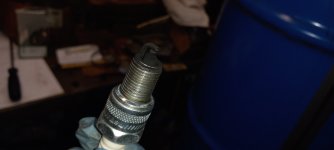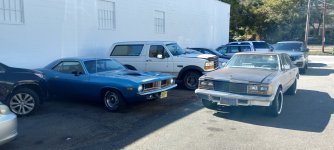Plug readings on an engine that hasn't been driven are essentially useless, especially when most of its run time has been at idle with the choke engaged. They'll always look like that. There's no use in reading the plugs until after it's been driven. I'm not sure which plugs you're using, but they should be Champion. The original plug was an N9Y (now known as an RN9YC, Champion stock number 415), which is a pretty cold plug. The current recommendation--no doubt EPA-inspired--is an RN14YC (stock #405), which is five heat ranges hotter. That hotter than I'd like for driving. However that is the plug I'd suggest using until the choke and mixture is sorted. Once it's running like a champ, change out to RN12YC (a.k.a. stock #404). Both the RN12YC and the RN14YC are pre-gapped by Champion at .035".
No, changing from an RN14YC to the RN12YC will not require re-tuning. Heat range has nothing to do with spark intensity, duration, etc. It's simply a measure of how quickly the tip of the plug cools off. A hotter plug is less likely to collect deposits, while a colder plug is more-easily fouled. However, a colder plug is also less likely to detonate, and since this will be primarily a hot-weather car, I'd suggest the 12 over the 14 for summer cruising.
Just as a reminder, and I'm always astounded by the number of people that don't know this: The idle mixture screws will have little to no effect until the engine is
at operating temperature--180° or above--and the choke is
fully off. The fuel demands of a cold or cool engine are dramatically different than those of an engine at operating temperature. If one gets an engine tuned in nicely and it's only at 140°, it's going to be a lean-running, missing, spark-knocking misery at 180°. Furthermore, with the choke even partially engaged, that added vacuum will pull fuel out of every available metering orifice, not just the idle feeds.
The choke needs to be the first thing that's adjusted correctly. If that's off it'll throw everything else out of whack, including the idle speed.
I thought you'd had all the choke and idle-speed stuff handled already.
go to 17BTDC on the timing & work back till the vacuum drops 1 inch if it doesn't ping your good!
I've never heard of starting at a number and working backward. Seriously. That's absolutely a bass-ackward way of doing it (and why I don't ask retailers for tech advice). What if it
doesn't ping at 17°BTDC? What would the reasoning be for backing it off? I've daily-driven cars with as much as 26° initial and no spark knock, even on steamy summer days.
In general terms, I'll use a dial-back timing light to set the total advance (once I know all the mechanical is in, at say 3,000RPM) to 34° and let the initial fall where it may. If it detonates at light/partial load, I'll slow down the rate of vacuum advance by adjusting the screw inside the vacuum nipple until the ping stops.
The easiest way, though, is the Big Fat Friend method: Set your timing at, say, 12°BTDC. On a warm day, get the heaviest person you know to ride along (or get some weight in the car--300+lb is good), and find the steepest hill you can. From a dead stop at the bottom of said hill, accelerate at about 3/4 throttle up the hill. Do you hear spark knock?
If yes, back it off a degree and try again. Keep backing off a degree at a time until no ping is heard.
If no, advance it two degrees and try again. Keep advancing it until you hear a ping, back it off one degree, and retry. If it pings again, back it off another degree and call it a day.
Now that the engine's good and hot, shut it off and wait about 10 minutes. Try starting it again. Does it start OK? You're done. Does it turn over very slow and very hard, like the battery's weak? Take out another couple of degrees and try it again after another heat soak. Keep the timing where you've got the best balance between maximum timing and easy hot starts.
That's how I timed my 400 Trans Am and my 440 Charger. The T/A would not start above 70° outside temperature with 26° so I backed it off to 24. The Charger was at 16°. Never had a spark knock in the T/A, and only had it in the Charger on triple-digit Atlanta summer days--and it was very faint.
I think he's going to do the timing first, clean & regap the plugs & see if that helps before he tears the BRAN NEW CARB apart to see if there's any damage at the adjustment screw ports???
There's no damage to the mixture screws. At worst, someone over-tightened them and even if that's the case, they still deform in a taper that matches the screw. That'll affect the initial adjustment a bit--maybe 1 turn out as a starting point instead of 1-1/2--but they should still work.
Throw the fouled plugs out and get new ones. Cleaning spark plugs is a fool's errand; they never work as they should after they foul. I've wasted a lot of time in my life standing at a plug blaster only to have the plugs foul again after 5-10 minutes of use.





